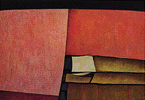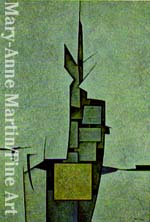Gunther Gerzso
80th Birthday Show
|
 |
|
Gunther Gerzso
Dore Ashton
|
|
| page 1 | page 2 | page 3 | page 4 |
|
|

22. Verde-azul-amarillo, 1968 |
If I
speak of Gerzso's initial formation as an independent painter, I must
emphasize that it was his return to Mexico in 1942, after several years of
being a resident set designer in the United States, that fortified his resolve.
He returned to his birthplace, I suspect, with the express intention of making
it his own; of coming to terms with its strangeness, its overwhelming
feeling of profound apartness from all other Western culture. Even
native-born Mexicans are aware of the peculiar otherness of Mexico, and in
awe of it. Carlos Fuentes has spoken of all of Mexico as a "sacred zone," and
Octavio Paz has written again and again of Mexico's unique heritage
stemming from its unusual fusion of colonial and Indian elements. Gerzso
was clearly smitten and inspired by his rediscovery of his native country.
His enthusiasm was undoubtedly swiftly kindled by the presence of a small
but infinitely important group of foreign painters and poets who had taken
refuge, during the Second World War, in Mexico City. The whole story has yet
to be told, but the heroic years of Surrealism in Mexico were to be definitive
in its cultural evolution. The tremendous energy such people as Wolfgang
Paalen and Leonora Carrington and the poet Benjamin Péret brought to Mexico
City was unparalleled. This energy was quickly put into the service of the
important esthetic battle against an ingrained and unchallenged habit of
assuming, as most Mexicans did, that the art of the great generation of
muralists was the only indigenous modern art possible. The Surrealist band,
with their emphatic emphasis on free association and the importance of
reverie, would be effective in opening a way for young artists to elude the
mural tradition.
Gerzso profited by the momentary excitement. He soon came to know
Wolfgang Paalen, a well-traveled and exuberant painter who had arrived in
Mexico full of enthusiasm for the American indigenous traditions (he had
first visited Alaska and the Pacific Northwest where he studied Indian arts).
Paalen's response to the Mexican landscape reflected the Surrealist état
d'âme even after he renounced certain Surrealist tenets. He wrote in a letter
of "the sullen greatness of this high plateau ... its emptiness under a
fathomless sky whose clouds are piled up so high that one grasps
immediately the thirteen heavens of the Indian mythology..."
He quickly
grasped Gerzso's individual adaptation of Surrealist juxtapositions, and
when he wrote the catalogue foreword for Gerzso's first exhibition in 1950,
he spoke of things that are still pertinent to Gerzso's vision:
It might seem strange to speak of Mayan monuments and Kafka in the same
breath; yet the fathomless antechambers in the writer's castles, the walls
of his imaginary China, can be sensed on the ascending terraces, in the
endless vaults and pyramids of pre-Cortesian Mexico. There are no
milestones in eternity, and the lonely men on their way from the lost city to
the possible city have come to know that the nearest is also the farthest. For
them, the ancient glyphs which can no longer be read, and the glyphs which
cannot be read yet, are equally meaningful.
Certainly the monuments of the old Indian theologies with their rectilinear
shapes and their uncanny perceptual effects are to this day engraved in
Gerzso's imagination and peer out from his seemingly abstract works. The
Surrealist point of view-for more than anything else, Surrealism was a point
of view of existence-has remained germane to his creation.
|
| continued |
|






|











